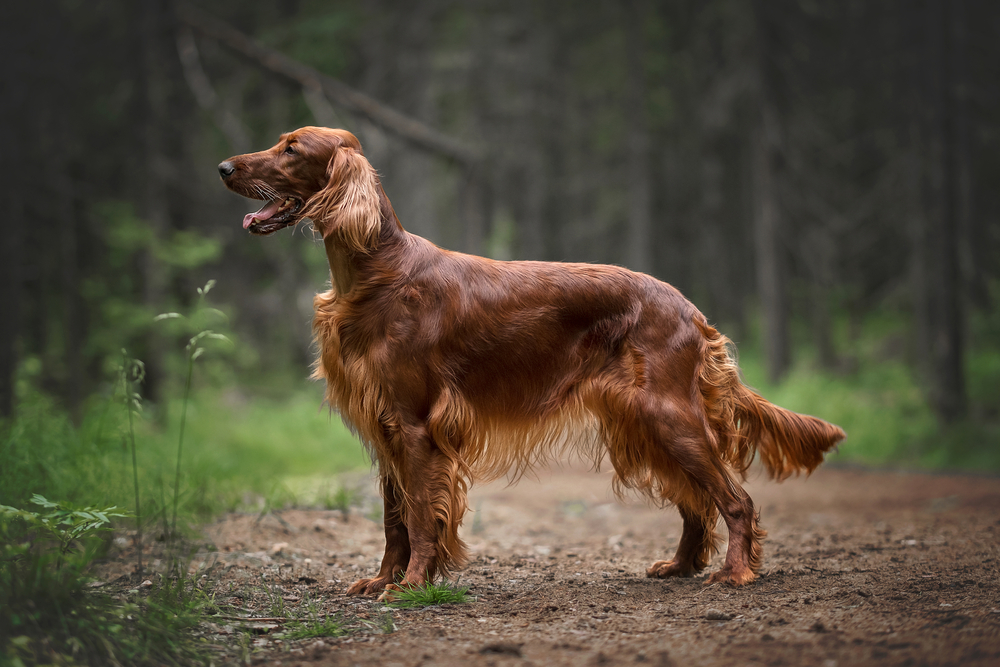
A common refrain in the history of many of our old breeds is: “Lost in the mists of time.” For people who are keen to learn more about the early days of their breeds, it is disappointing.
Affectionados of a given breed, then, should regard themselves as lucky if the people who came before them kept records or had a strong oral tradition so that admirers of the breed today know who contributed what to their breed.
If what we’ve read about the Irish Setter is accurate, several people of the past have given us a gift by sharing a little something about color in this breed gleaned by talking to breeders of their day, and then writing it down.
For instance: Field bred dogs of the day were more likely to be a lighter shade of red than the show dogs at the time. This inference is from something written in the late 1800s by Rawdon B. Lee. He wrote in “Modern Dogs/Sporting Division:“...the red dogs of the past and even those shown at the earlier shows were not nearly so deep in colour as many now before the public on the benches. The Irish Red Setter Club’s own rules state that the correct colour is “a rich golden chestnut.” Lee’s observation came after he had spoken with prominent Irish Setter breeders of the day, including Cecil Moore, breeder of “Palmerston” whom we’ll get to later on, but the notion was supported by legendary Irish breeder, John Nash. The founder of Moanruad Kennel went so far as to express his opinion that the lighter shade of red could be traced to a dog born in 1900, “Young Phil.”
Nash had no proverbial “dog in the fight” with regards to color, his contributions to be breed more focused on maintaining working and hunting abilities of the breed, but three years after Young Phil was whelped, Nash did pen a description of the dog in, “A History and Description of the Modern Dogs of Great Britain and Ireland: Sporting Division.” He wrote: “Young Phil was not himself a great worker, but he was supposed to be very brainy and possess a superlative nose, but not over-endowed with pace or drive, he was a lighter color red than usual, and begot much lighter color dogs, and possibly on this count alone, occurred the great divergence between the working and show Irish Setter. Though one does see some very good dark red dogs, most of the workers are of a lighter hue than is fashionable on the bench.”
Curiously, one Irish Setter owner who felt that the authentic color of the breed was blood-red owned the dog who is believed to have tacitly encouraged breeders to breed for deep red. “Frisco,” owned by one Colonel Millner, author of, “The Irish Setter – Its History & Training,” published in 1924. While the book is considered a classic in the field, Frisco, impactful as he was, was not the “landmark” Irish Setter that another dog was. That other dog’s name was Ch. Palmerston.
Palmerston, born in Ireland in 1862, was a sensation in the show dog scene. The longer-necked red-mahogany dog inspired a preference for all-red dogs, but his breeder, Cecil Moore, so disliked the dog’s lighter bone for field work that he ordered one of his men to drown the dog rather than put him in the hands of someone who might actually hunt over him. To our great relief, an “intervention” came in time to save the dog. A certain Mr. Hilliard begged Cecil Moore to spare the dog, and Moore agreed to give Palmerston to Hilliard but only if the dog was kept for show purposes. The rest is history. Palmerston proved to be an enormous success in the dog fancy. He went on to sire many puppies, and it’s said that nearly every Irish Setter alive today can be traced back to him.
Palmerston, Young Phil, Frisco were hugely influential dogs, and we only know them about over 130 years because of people who cared enough to write about them.
Image of Irish Setter by ph_non stop / Depositphoto
